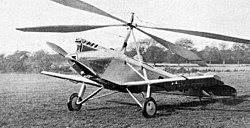Cierva C. 17
| Cierva C. 17 | |
|---|---|

|
|
| Type: | Gyroplane |
| Design country: | |
| Manufacturer: | |
| First flight: |
October 23, 1928 |
| Number of pieces: |
2 |
The Cierva C.17 (Avro 612 and 620) was a gyroplane that was built in two copies in Great Britain at Avro in the late 1920s under a license from the Cierva Autogiro Company .
history
The encouraging results of the testing of the Cierva C.8 L Mk.II prompted Avro to develop a smaller version for use by private individuals and air sports clubs. The basis of the C.17 was the Avian IIIA equipped with a 90 hp ADC Cirrus III . As the C.8L the C.17 used a rotor with blades of the "paddle-type", equipped with impact and pivoting joints . The rotor head sat on a tripod made of clad steel tubes and was set in rotation either by hand or with the help of a rope before take-off. The wing was braced against the fuselage and carried unbalanced ailerons over the entire span. The landing gear consisted of two half landing gear units of the Avian IIIA. The standard Avian tail unit was shortened significantly to maintain a sufficient distance to the rotor.
Juan de la Cierva was at the wheel himself on the first flight of the C.17 (Avro 612, registration G-AABP) on October 23, 1928. The machine turned out to be so underpowered that it had to be scrapped in Hamble. With the Cierva C.17 Mk. II (Avro 620) , a second example was built in early 1929 with a slightly more powerful radial engine Avro Alpha that made 100 hp. This execution was also unsuccessful.
A third machine, similar to the C.17 Mk. II, but with rectangular rotor blades, was used as the Cierva C.12 to test the rotor system . Cierva made the maiden flight of the C.12 itself in 1929. After being converted into a single-seat version equipped with Avian metal floats, he also took the helm for the maiden flight on April 25, 1930 in Southampton. Also known as Hydrogiro , this variant was the first gyroplane seaplane . There are clear indications that the C.12 was an intermediate state of construction of the C.17 Mk. II before it was finally dismantled into the Avro 594 Avian II (registration G-ADEO).
Technical specifications
| Parameter | C. 17 Mk. II |
|---|---|
| crew | 2 |
| length | 8.77 m |
| Rotor diameter | 10.14 m |
| Rotor speed | 130 min −1 |
| height | 3.38 m |
| Empty mass | 459 kg |
| Max. Takeoff mass | 656 kg |
| Top speed | 144 km / h |
| Cruising speed | 112 km / h |
| Range | approx. 340 km |
| Engine | an air-cooled radial engine Avro Alpha with an output of 100 PS (74 kW) |
See also
literature
- Arthur WJG Ord-Hume: Autogiro - Rotary Wings Before the Helicopter , Mushroom Model Pub., 2009, ISBN 978-83-89450-83-8 , p. 75 f., P. 289
- Planes from A – Z - Cierva Autogyros . In: AERO - The illustrated compilation of aviation. No. 51, pp. 1424 ff., 1984, Marshall Cavendish.
- TR Hiett: Cierva's rotating wings . In: AIR Enthusiast July / August 2003, pp. 26–31
- AJ Jackson: Avro Aircraft since 1908 , Putnam, 1965, 2nd edition 1990, ISBN 0-85177-834-8 , pp. 263-264
Web links
Individual evidence
- ↑ Not to be confused with the gyroplane Cierva C.12 built in Spain , which, curiously, had the same name
- ↑ Jackson, 1990, p. 264

